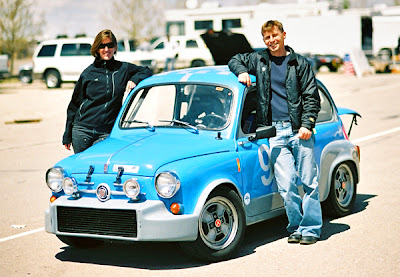 From the Aug. 30 edition of Drive, The New Mexican's weekly car magazine, by Jay Binneweg:
From the Aug. 30 edition of Drive, The New Mexican's weekly car magazine, by Jay Binneweg:Santa Fe team counting down to the Carrera Panamericana
Before they begin their seven-day, 2,000-mile race across Mexico, locals need your help!
The clock is ticking down for the Santa Fe team preparing to race a 1957 Fiat 600 Abarth across Mexico in La Carrera Panamericana 2007, which runs Oct. 26 to Nov. 1. The seven-day, 2,000-mile route, from Oaxaca to Nuevo Laredo, mirrors the 1950 race that celebrated completion of the Mexican section of the Panamerican Highway.
Stacy Bishop and Luca Maciucescu have been working to get their classic racing Fiat up to spec. So far they’ve rebuilt the transmission, suspension and the main and spare engines; the car has new shocks, and the generator has been replaced with an alternator. Plus, the brake and electrical (naturally) systems needed a thorough going-over.
Still on the to-do list is replacing the glass windows with Lexan and rebuilding and/or checking all the safety systems: roll cage, seatbelts and emergency fire system. You know, the little things.
Because it’s there: When we first told readers about the team’s preparations, in the July 5 issue of Drive, we got a number of questions, but most of all, “Why?”
As Luca, who loves working on and driving classic cars, explains, “I had always intended to race the Carrera, an endurance test of a race that has such a rich history, where only cars of a certain age can run. I didn’t know when or how, but Dario Castino, our chase-car driver, pushed us, and we finally agreed there is no time like the present. So, here we go.”
Stacy picks up the thread: “I had never been racing before, and I couldn’t wait to learn, but you just can’t learn in the type of car most other race teams are bringing: old Chryslers and Studebakers, Mustangs and Porsches. Our goal is to start and finish the race and have as much fun as possible in between.”
“Yes, doing a race in a fast car, for the first time, is a recipe for disaster,” Luca agrees. They needed a smaller car, a car that excelled at overall handling instead of just brute power; because the race course includes a devilish mix of mountain switchbacks and flat-out straights, there would be no “right” car, just one that suited the racers. The car also had to be easy to work on, with all the parts accessible — both for preparation and for fixes during the race.
Though the individual daily stages will be plenty grueling, the race itself is not a start-to-finish free-for-all: Drivers will set off each morning, their departures staggered, and they’ll be timed to a checkpoint, and lunch.
After lunch there’ll be another stage, racing to dinner and a hotel bed in some of the most famous and picturesque cities in Mexico: Tuxtla Gutierrez, Oaxaca, Puebla, Aguascalientes, Mexico City, Querétaro and Zacatecas.
Since this is also meant to be fun, Stacy wanted something sporty, but not intimidating; a smaller car would help with fuel consumption. All of those considerations lead to the Fiat, which Luca found for sale in California: “We wanted something we could complete the race in.” Stacy fell in love.
A race just to start: But she hasn’t been able to drive it nearly as often as she’d like. Yes, access is easy for repairs — the rear engine and transmission can be simply lowered and removed, as in a VW Bug — but parts have been surprisingly hard to come by, and pricey.
As Luca says, “If you were on an unlimited budget, you’d just have everything rebuilt. But no one can afford to spend the time an owner can; plus, we just want to have fun on a reasonable budget.”
Fiat 500 and 600 models put Italy on wheels, like the Beetle in Germany and the Mini in England. Millions were built, but few made it to our shores, so there are few spares to be found.
So, Stacy and Luca have been doing all the work themselves, with the help of local experts: Jess’ Performance Machine has been extremely helpful and generous with their time and expertise while the couple rebuilt the engine and transmission, and a local mechanic, Stephen Charbonneau, is helping them sort out the electrical system, after reading about the adventure in Drive.
Join the team: Dario Castino and David Crane will drive the chase Land Rover and act as backup drivers. The whole effort is volunteer, a group of friends.
They’re also doing it on a shoestring budget and are asking local businesses and individuals if they’d be interested in helping out — sponsoring the team, donating needed parts, lending expertise, etc.
As with any race team, sponsors will get to announce their contributions on the car and as the wish list below is filled.
If we can figure out a way – one of the places everyone reading this comes in – to set the team up with the right equipment and expertise, we’ll bring you up-to-the-minute progress reports, photos and video right here.
If you have any questions or would like to be part of the effort, e-mail Stacy at nmcarrerapanamericana2007@yahoo.com.
